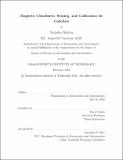Magnetic Cleanliness, Sensing, and Calibration for CubeSats
Author(s)
Belsten, Nicholas
DownloadThesis PDF (33.18Mb)
Advisor
Cahoy, Kerri
Terms of use
Metadata
Show full item recordAbstract
Magnetometers are widely used on satellites for both attitude sensing and scientific observations. Spaceborne magnetometers have enabled the creation of accurate maps of Earth’s magnetic fields. However, these models have limited spatial and temporal resolution, and therefore are much less accurate in locations with fast or localized magnetic perturbations. Such perturbations can be particularly problematic near Earth’s poles where field aligned currents come close to the surface of the Earth and are concentrated near satellites in LEO. Science missions which need to know the local magnetic field in the polar regions need to bring their own high-fidelity magnetic sensors.
The AERO-VISTA mission comprises a pair of 6U CubeSats which will determine the propagation modes and directions of high frequency (400 kHz–5 MHz) waves in Earth’s ionosphere in the presence of Earth’s aurorae. This mission science requires accurate in-situ magnetic sensing of auroral currents for RF measurement context. This thesis details the design, integration, and testing of the magnetic sensors in the AERO-VISTA Auxiliary Sensor Package (ASP). We discuss the estimation of spacecraft self-interference and implement an informal magnetic interference control process. We present some simple ground testing strategies for magnetic screening of components and measurement of spacecraft self-interference. We evaluate the performance and non-ideal effects of our selected anistropic magnetoresistive (AMR) 3-axis magnetometer. We create a measurement equation, which together with regression techniques, allows for calibration to better than 100 nT repeatability despite non-ideal effects, meeting AERO-VISTA’s requirements. This calibration strategy is extended to include current path and material interference effects. We describe the detailed design of the magnetic sensing system, including the electronics, mechanical design, and software of the ASP. Without self-interference effects, this design has a noise floor better than 10 nTrms.
Date issued
2022-02Department
Massachusetts Institute of Technology. Department of Aeronautics and AstronauticsPublisher
Massachusetts Institute of Technology